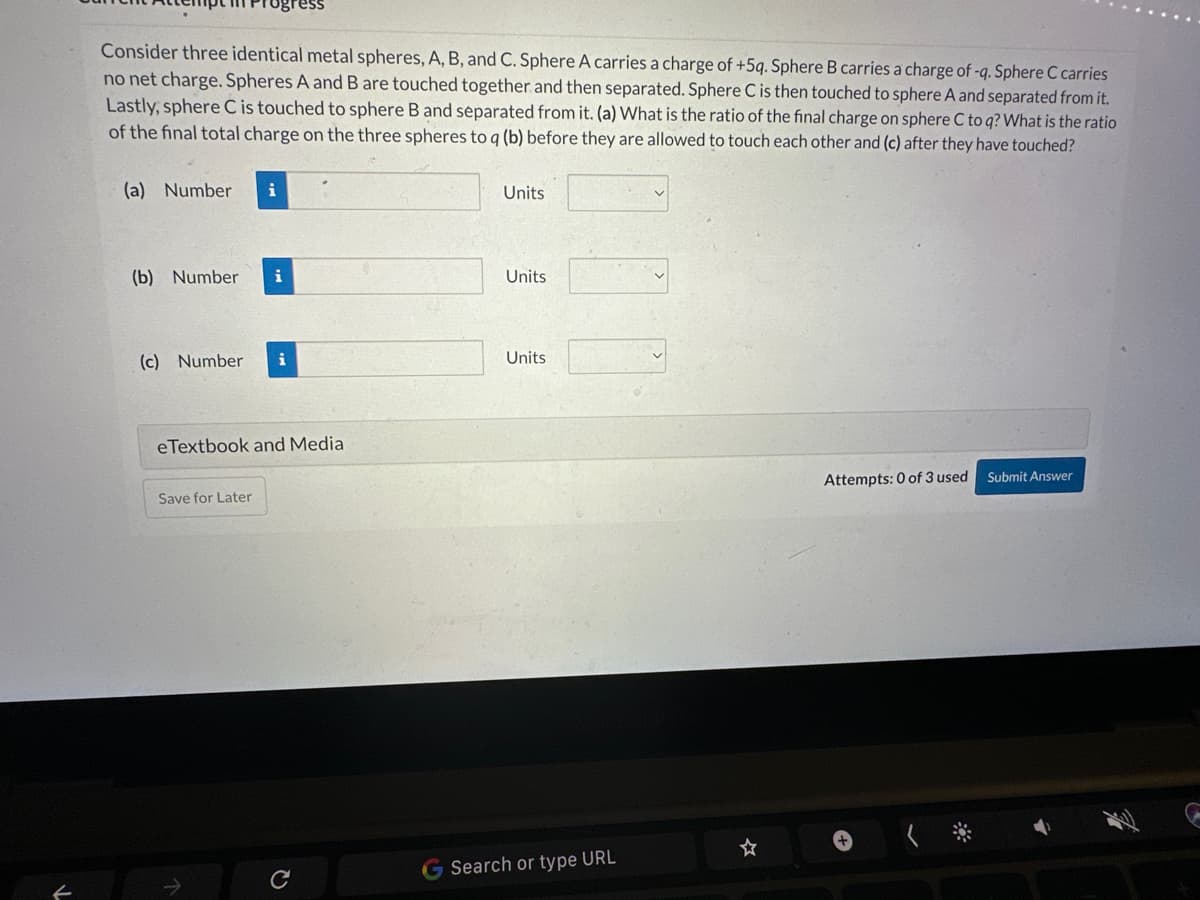Consider three identical metal spheres, A, B, and C. Sphere A carries a charge of +5q. Sphere B carries a charge of -q. Sphere C carries no net charge. Spheres A and B are touched together and then separated. Sphere C is then touched to sphere A and separated from it. Lastly, sphere C is touched to sphere B and separated from it. (a) What is the ratio of the final charge on sphere C to q? What is the ratio of the final total charge on the three spheres to q (b) before they are allowed to touch each other and (c) after they have touched? (2) Number Unite
Consider three identical metal spheres, A, B, and C. Sphere A carries a charge of +5q. Sphere B carries a charge of -q. Sphere C carries no net charge. Spheres A and B are touched together and then separated. Sphere C is then touched to sphere A and separated from it. Lastly, sphere C is touched to sphere B and separated from it. (a) What is the ratio of the final charge on sphere C to q? What is the ratio of the final total charge on the three spheres to q (b) before they are allowed to touch each other and (c) after they have touched? (2) Number Unite
Physics for Scientists and Engineers: Foundations and Connections
1st Edition
ISBN:9781133939146
Author:Katz, Debora M.
Publisher:Katz, Debora M.
Chapter23: Electric Forces
Section: Chapter Questions
Problem 42PQ: Three identical conducting spheres are fixed along a single line. The middle sphere is equidistant...
Related questions
Question
help asap (not in scientific notation(

Transcribed Image Text:Consider three identical metal spheres, A, B, and C. Sphere A carries a charge of +5q. Sphere B carries a charge of -q. Sphere C carries
no net charge. Spheres A and B are touched together and then separated. Sphere C is then touched to sphere A and separated from it.
Lastly, sphere C is touched to sphere B and separated from it. (a) What is the ratio of the final charge on sphere C to q? What is the ratio
of the final total charge on the three spheres to q (b) before they are allowed to touch each other and (c) after they have touched?
(a) Number i
(b) Number i
(c) Number i
eTextbook and Media
Save for Later
C
Units
Units
Units
G Search or type URL
Attempts: 0 of 3 used
Submit Answer
Expert Solution
This question has been solved!
Explore an expertly crafted, step-by-step solution for a thorough understanding of key concepts.
Step by step
Solved in 2 steps with 2 images

Knowledge Booster
Learn more about
Need a deep-dive on the concept behind this application? Look no further. Learn more about this topic, physics and related others by exploring similar questions and additional content below.Recommended textbooks for you

Physics for Scientists and Engineers: Foundations…
Physics
ISBN:
9781133939146
Author:
Katz, Debora M.
Publisher:
Cengage Learning

Principles of Physics: A Calculus-Based Text
Physics
ISBN:
9781133104261
Author:
Raymond A. Serway, John W. Jewett
Publisher:
Cengage Learning

Physics for Scientists and Engineers, Technology …
Physics
ISBN:
9781305116399
Author:
Raymond A. Serway, John W. Jewett
Publisher:
Cengage Learning

Physics for Scientists and Engineers: Foundations…
Physics
ISBN:
9781133939146
Author:
Katz, Debora M.
Publisher:
Cengage Learning

Principles of Physics: A Calculus-Based Text
Physics
ISBN:
9781133104261
Author:
Raymond A. Serway, John W. Jewett
Publisher:
Cengage Learning

Physics for Scientists and Engineers, Technology …
Physics
ISBN:
9781305116399
Author:
Raymond A. Serway, John W. Jewett
Publisher:
Cengage Learning

Physics for Scientists and Engineers with Modern …
Physics
ISBN:
9781337553292
Author:
Raymond A. Serway, John W. Jewett
Publisher:
Cengage Learning

Physics for Scientists and Engineers
Physics
ISBN:
9781337553278
Author:
Raymond A. Serway, John W. Jewett
Publisher:
Cengage Learning

College Physics
Physics
ISBN:
9781305952300
Author:
Raymond A. Serway, Chris Vuille
Publisher:
Cengage Learning